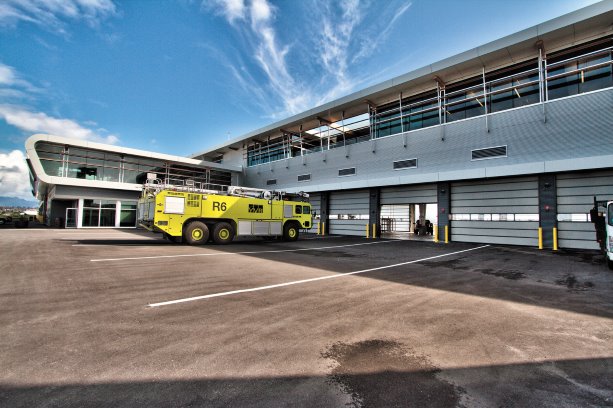Graham Construction and Engineering LP has won a Vancouver Regional Construction Association (VRCA) Silver Award of Excellence in the General Contractor Over $40 Million category for its work on the new Air-side Operations Building (AOB) at Vancouver International Airport (YVR) in Richmond.
"Every airport has emergency response services, maintenance shop, runway deicing services (and other similar services)," said Graham Construction district manager Jason Glue. "In the past, all of these services had their own independent facilities in different parts of the Vancouver airport. The air-side operations building combines them all in one location."
Situated between the domestic and international terminals, the AOB is a post-disaster (storms, floods, earthquakes, etc.) facility that will act as a hub for air-side operations and as a staging area for air-side maintenance activity. The air-side is the side of an airport terminal from which aircraft can be observed. The $43.5 million facility includes a fire hall, maintenance shop, indoor parking garage, office space, training rooms, fitness centre, and a materials storage building with vehicle wash bays and a fueling complex. The AOB is equipped with data, communication, emergency power and security systems that enable it to act as a back-up airport operations centre. The facility, which is owned by the Vancouver International Airport Authority, is three-storeys high and has an area of 87,000 square feet. Building materials include glulam beams and cross-laminated wood roof panels; a low-sound transmission curtain wall system; composite aluminum panels and corrugated metal cladding; stackable overhead doors; and low-sound transmission roof insulation. The facility has a number of "green" features.
They include photovoltaic and hot water solar panels, a rainwater harvesting system and a wind turbine. Other good-for-the-planet attributes are a geothermal field, underground storm water storage and a heat exchanger that allows recuperate energy that has been rejected by the emergency generator to be used to heat the building. Glue said that although the owner didn’t apply for LEED certification, 90 per cent of all of the AOB’s project specifications are typical LEED specifications.
"Compared to the average for conventional buildings, the AOB achieved almost 50 per cent energy savings," he said. "Because it is a post-disaster facility, the facility is self-sustainable and can operate independently and as a back-up data operations centre if there is a disaster." Glue said the AOB was the first project at Vancouver airport with complete energy monitoring.
"All building systems can be monitored remotely," he said. "You can control the entire building – heating, cooling, doors, fuel systems, fire alarm, lighting, energy monitoring, security, CCTV – from a laptop."
Glue said the project presented a number of challenges.
"The main challenge was co-ordination and compliance with airport security, safety and operational constraints," he said.
Access restrictions required all workers to have government-issued photo identification and to be escorted to and from the work site by YVR security. "Graham purchased a school bus that was used as a shuttle by its workers and used bar codes and infrared scanners to monitor site personnel," Glue said. Because the AOB is located between YVR’s domestic and international terminals, the project involved service interconnections that ran across four taxiways to utility sources at the terminal.
"All of the airfield utilities were installed at night, when the airport runways were closed," Glue said.
Vancouver’s climate presented challenges, too. Bad weather and low visibility contributed to 30 lost days on the project.
"Weather conditions make air-side projects unpredictable and prone to interruptions," Glue said. "So, it was critical to move airfield maintenance services to the facility before winter operations went into effect in November, in order to prevent delays in the following season."
Due to the AOB’s exposure to high winds, special attention was paid to envelope assemblies and the sequencing of roofing and cladding construction. Multiple occupancies put additional pressure on the contractors.
"YVR wanted to take over every time new areas of the building became available," Glue said. "As a result, Graham handed over the building in five different phases, which meant the airport didn’t have to wait for overall completion."
Construction of the AOB ran from July 2013 to February 2015. In addition to Graham, Division 15 Mechanical Ltd. won a Silver Award of Excellence in the Mechanical Contractors over $2.5 million category for its work on the project.












Recent Comments
comments for this post are closed